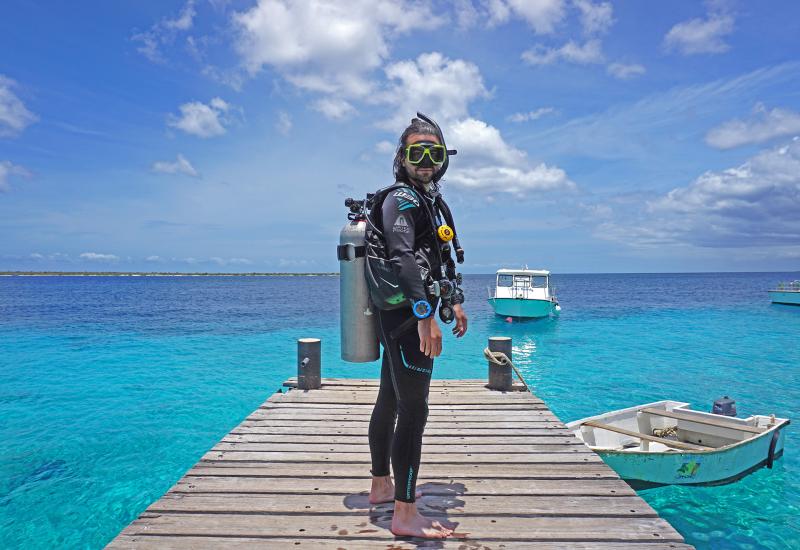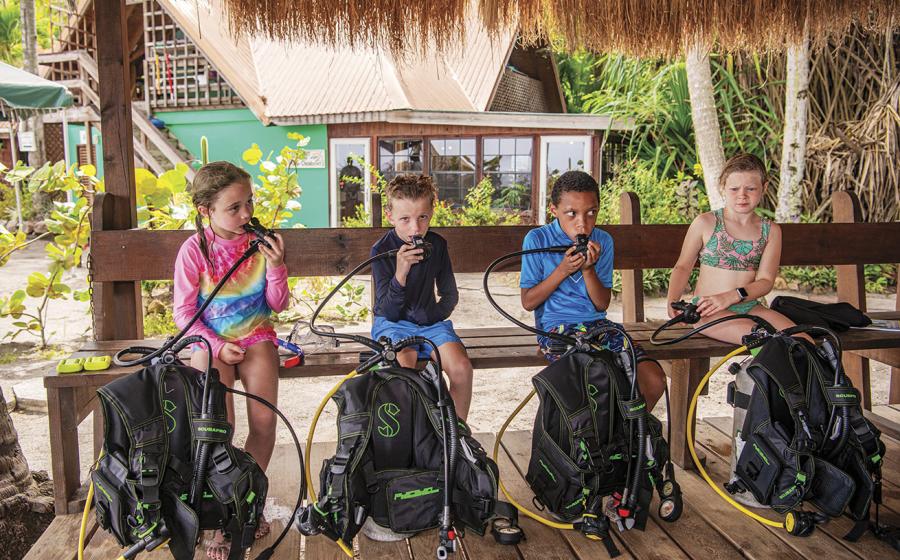Ask An Instructor - September 2008
By Michael Ange
Q: After my last two regulator services, I had total regulator failures--a continuous free flow in one case and my second stage shut down in the other. I have repeatedly read in magazines and in my owner's manual, plus been told by my instructor and dive store, that I should service my equipment every year, but it seems like the only time I have issues with my equipment is just after I have it serviced. I do about 20 dives per year, and I clean my equipment well after every dive. Does this rule really apply to me?
A: Yes, you should have your equipment serviced in accordance with the manufacturer's recommendations. Not only will this vastly extend the life of your equipment but it will also ensure that the manufacturer will honor its warranty agreement. And the less you use your equipment, the more important service becomes. The soft parts inside the regulator are likely to suffer damage from ozone and other atmospheric contaminants if they sit unused for long periods of time. Also, every regulator is subject to small amounts of corrosion, no matter how well it is cleaned. Frequent use of the regulator breaks up this corrosion and limits its growth. But a little spot of corrosion allowed to grow unimpeded for weeks or months can turn into a major problem.
It sounds like your problem is actually with bad service not service in general. Just like auto mechanics, there are good technicians and bad ones. Here are two important things to look for in a good technician:
1) The proper equipment to do the job. Ask to see the technician's repair room. The facility should be clean and orderly with the tools in their appropriate places. Be wary of a workbench with dirty tools piled haphazardly all over the place. And the dive center must have, at a minimum, a magnehelic gauge for setting breathing resistance on the second stage and an intermediate-pressure gauge used to set the intermediate pressure of the first stage. There is no substitute for these gauges--no matter what.
2) Up-to-date and valid certifications issued by the manufacturer of your equipment. Every technician should go through an update at least once every two years. At every update, the technician is issued a certificate to prove he or she has attended. If it isn't displayed, ask to see it.
Q: I am a new diver with nine dives logged, and I want to get my advanced certification. How many dives do I need to start advanced training, and what skills should I work on to prepare myself?
A: The details of an advanced course depend on the certification agency. Some courses--such as the one offered by PADI, the largest certification agency--consist of class work and five specialty dives to earn the certification. Required specialties included a deep dive and a navigation dive; for the others, you can pick from a long list that includes specialties like wreck, boat and drift diving, just to name a few. This class model gives you an introduction to different diving experiences, but it neither requires you to complete detailed training in any of those areas, nor does it require any additional experience outside of the class dives.
Other classes, such as the one offered by SSI, another popular training agency, require in-depth training in four or five specialty areas along with a certain number of total logged dives, usually around 25, as part of the advanced certification.
Neither model requires a minimum number of dives beyond your certification dives to enroll in the course--so you can start your training now. And both have fairly well-proven track records, so you should pick the one that works best for you. If your focus is to have fun, to get more instructor supervised time in the water and to get a good introduction to the different types of diving available to you, the shorter, five-dive course will work well. On the other hand, if you want detailed training in specific specialty areas, you should go with a more comprehensive course.
Also, you don't have to show up for class with any special skills beyond what you learned during initial certification, but if you want to really shine among your peers, focus on perfecting your buoyancy control. This is a valuable skill that you should practice on every dive, as this will help you be a better diver no matter what kind of diving you do.
Q: I have heard it's better to use the back pull dumps on my BC rather than the deflate button on my hose. Do the pull dumps have check valves to stop water from entering the BC? If not, what exactly are the advantages?
A: the pull dumps do not have check valves to stop water from entering the BC, so you'll still need to empty the water from your BC after diving. The benefit of pull dumps is they allow you to dump air efficiently, depending on your position in the water. For example, if you're swimming in a normal face-down position and need to vent air, using your hose will require you to stop swimming and turn your body vertically in the water. This pauses your dive and, overall, takes time and effort. In this situation, using the pull dump on your lower back lets you vent air without stopping by simply angling your body slightly downward. Additionally, the best way to keep water out of your BC is to make sure you're weighted properly. If you're overweighted and constantly adding and removing air, you'll let in a lot of water just because you're constantly opening the valves. With proper weighting, you'll minimize the use of your inflator/deflator and therefore the amount of water that can get in.
Q: I do a fairly good job with compass navigation in the daytime, but at night I seem to have difficulty navigating even a simple out-and-back pattern. My compass doesn't work any differently at night, so what am I doing wrong?
A: It's difficult to say exactly without seeing you in the water, but here are three tips for dealing with the most common nighttime navigation problems:
1) Make sure the compass stays level. If you tilt the compass just a little bit, the rotating card inside cannot turn freely and you'll get an inaccurate heading. This is easier to do in the daytime because you have a bottom reference to align the compass with. At night, instead of trying to align the entire gauge console with the ground, watch the card and make sure it stays an equal distance from the top of the case on all sides.
2) Become one with the compass. Since the most effective navigation is a combination of natural and compass navigation, the loss of visual reference at night means it's harder to follow features of the reef as a supplement to your compass navigation. You are almost completely dependent on the compass this way, and the only cure is lots of practice. Try running compass patterns in the daytime over an area without bottom features, such as a clear, sandy bottom.
3) Light up the boat. In the daytime you might be able to see the boat from 100 feet or more in clear water. At night, you may need to be within 25 feet to see it. One way to increase the boat's visibility is to hang a light stick or small strobe on the ladder or mooring line so you'll see the glow when you get close.
Got a question you need answered?
E-mail it to [email protected], or write to:
Ask An Instructor
6600 Abercorn St., Suite 208,
Savannah, GA 31405
By Michael Ange
Q: After my last two regulator services, I had total regulator failures--a continuous free flow in one case and my second stage shut down in the other. I have repeatedly read in magazines and in my owner's manual, plus been told by my instructor and dive store, that I should service my equipment every year, but it seems like the only time I have issues with my equipment is just after I have it serviced. I do about 20 dives per year, and I clean my equipment well after every dive. Does this rule really apply to me?
A: Yes, you should have your equipment serviced in accordance with the manufacturer's recommendations. Not only will this vastly extend the life of your equipment but it will also ensure that the manufacturer will honor its warranty agreement. And the less you use your equipment, the more important service becomes. The soft parts inside the regulator are likely to suffer damage from ozone and other atmospheric contaminants if they sit unused for long periods of time. Also, every regulator is subject to small amounts of corrosion, no matter how well it is cleaned. Frequent use of the regulator breaks up this corrosion and limits its growth. But a little spot of corrosion allowed to grow unimpeded for weeks or months can turn into a major problem.
It sounds like your problem is actually with bad service not service in general. Just like auto mechanics, there are good technicians and bad ones. Here are two important things to look for in a good technician:
1) The proper equipment to do the job. Ask to see the technician's repair room. The facility should be clean and orderly with the tools in their appropriate places. Be wary of a workbench with dirty tools piled haphazardly all over the place. And the dive center must have, at a minimum, a magnehelic gauge for setting breathing resistance on the second stage and an intermediate-pressure gauge used to set the intermediate pressure of the first stage. There is no substitute for these gauges--no matter what.
2) Up-to-date and valid certifications issued by the manufacturer of your equipment. Every technician should go through an update at least once every two years. At every update, the technician is issued a certificate to prove he or she has attended. If it isn't displayed, ask to see it.
Q: I am a new diver with nine dives logged, and I want to get my advanced certification. How many dives do I need to start advanced training, and what skills should I work on to prepare myself?
A: The details of an advanced course depend on the certification agency. Some courses--such as the one offered by PADI, the largest certification agency--consist of class work and five specialty dives to earn the certification. Required specialties included a deep dive and a navigation dive; for the others, you can pick from a long list that includes specialties like wreck, boat and drift diving, just to name a few. This class model gives you an introduction to different diving experiences, but it neither requires you to complete detailed training in any of those areas, nor does it require any additional experience outside of the class dives.
Other classes, such as the one offered by SSI, another popular training agency, require in-depth training in four or five specialty areas along with a certain number of total logged dives, usually around 25, as part of the advanced certification.
Neither model requires a minimum number of dives beyond your certification dives to enroll in the course--so you can start your training now. And both have fairly well-proven track records, so you should pick the one that works best for you. If your focus is to have fun, to get more instructor supervised time in the water and to get a good introduction to the different types of diving available to you, the shorter, five-dive course will work well. On the other hand, if you want detailed training in specific specialty areas, you should go with a more comprehensive course.
Also, you don't have to show up for class with any special skills beyond what you learned during initial certification, but if you want to really shine among your peers, focus on perfecting your buoyancy control. This is a valuable skill that you should practice on every dive, as this will help you be a better diver no matter what kind of diving you do.
Q: I have heard it's better to use the back pull dumps on my BC rather than the deflate button on my hose. Do the pull dumps have check valves to stop water from entering the BC? If not, what exactly are the advantages?
A: the pull dumps do not have check valves to stop water from entering the BC, so you'll still need to empty the water from your BC after diving. The benefit of pull dumps is they allow you to dump air efficiently, depending on your position in the water. For example, if you're swimming in a normal face-down position and need to vent air, using your hose will require you to stop swimming and turn your body vertically in the water. This pauses your dive and, overall, takes time and effort. In this situation, using the pull dump on your lower back lets you vent air without stopping by simply angling your body slightly downward. Additionally, the best way to keep water out of your BC is to make sure you're weighted properly. If you're overweighted and constantly adding and removing air, you'll let in a lot of water just because you're constantly opening the valves. With proper weighting, you'll minimize the use of your inflator/deflator and therefore the amount of water that can get in.
Q: I do a fairly good job with compass navigation in the daytime, but at night I seem to have difficulty navigating even a simple out-and-back pattern. My compass doesn't work any differently at night, so what am I doing wrong?
A: It's difficult to say exactly without seeing you in the water, but here are three tips for dealing with the most common nighttime navigation problems:
1) Make sure the compass stays level. If you tilt the compass just a little bit, the rotating card inside cannot turn freely and you'll get an inaccurate heading. This is easier to do in the daytime because you have a bottom reference to align the compass with. At night, instead of trying to align the entire gauge console with the ground, watch the card and make sure it stays an equal distance from the top of the case on all sides.
2) Become one with the compass. Since the most effective navigation is a combination of natural and compass navigation, the loss of visual reference at night means it's harder to follow features of the reef as a supplement to your compass navigation. You are almost completely dependent on the compass this way, and the only cure is lots of practice. Try running compass patterns in the daytime over an area without bottom features, such as a clear, sandy bottom.
3) Light up the boat. In the daytime you might be able to see the boat from 100 feet or more in clear water. At night, you may need to be within 25 feet to see it. One way to increase the boat's visibility is to hang a light stick or small strobe on the ladder or mooring line so you'll see the glow when you get close.
Got a question you need answered?
E-mail it to [email protected], or write to:
Ask An Instructor
6600 Abercorn St., Suite 208,
Savannah, GA 31405










